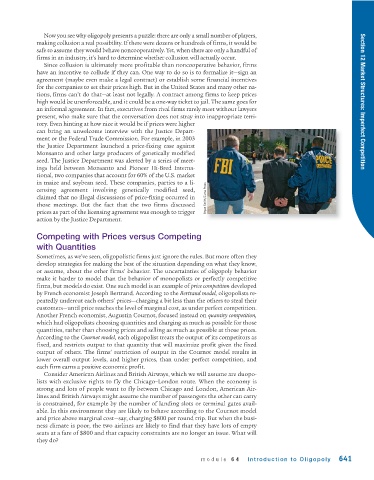Page 683 - Krugmans Economics for AP Text Book_Neat
P. 683
Now you see why oligopoly presents a puzzle: there are only a small number of players,
making collusion a real possibility. If there were dozens or hundreds of firms, it would be
safe to assume they would behave noncooperatively. Yet, when there are only a handful of
firms in an industry, it’s hard to determine whether collusion will actually occur.
Since collusion is ultimately more profitable than noncooperative behavior, firms
have an incentive to collude if they can. One way to do so is to formalize it—sign an
agreement (maybe even make a legal contract) or establish some financial incentives
for the companies to set their prices high. But in the United States and many other na-
tions, firms can’t do that—at least not legally. A contract among firms to keep prices
high would be unenforceable, and it could be a one-way ticket to jail. The same goes for Section 12 Market Structures: Imperfect Competition
an informal agreement. In fact, executives from rival firms rarely meet without lawyers
present, who make sure that the conversation does not stray into inappropriate terri-
tory. Even hinting at how nice it would be if prices were higher
can bring an unwelcome interview with the Justice Depart-
ment or the Federal Trade Commission. For example, in 2003
the Justice Department launched a price-fixing case against
Monsanto and other large producers of genetically modified
seed. The Justice Department was alerted by a series of meet-
ings held between Monsanto and Pioneer Hi-Bred Interna-
tional, two companies that account for 60% of the U.S. market
in maize and soybean seed. These companies, parties to a li-
censing agreement involving genetically modified seed,
claimed that no illegal discussions of price-fixing occurred in Bryan Smith/Zuma Press
those meetings. But the fact that the two firms discussed
prices as part of the licensing agreement was enough to trigger
action by the Justice Department.
Competing with Prices versus Competing
with Quantities
Sometimes, as we’ve seen, oligopolistic firms just ignore the rules. But more often they
develop strategies for making the best of the situation depending on what they know,
or assume, about the other firms’ behavior. The uncertainties of oligopoly behavior
make it harder to model than the behavior of monopolists or perfectly competitive
firms, but models do exist. One such model is an example of price competition developed
by French economist Joseph Bertrand. According to the Bertrand model, oligopolists re-
peatedly undercut each others’ prices—charging a bit less than the others to steal their
customers—until price reaches the level of marginal cost, as under perfect competition.
Another French economist, Augustin Cournot, focused instead on quantity competition,
which had oligopolists choosing quantities and charging as much as possible for those
quantities, rather than choosing prices and selling as much as possible at those prices.
According to the Cournot model, each oligopolist treats the output of its competitors as
fixed, and restricts output to that quantity that will maximize profit given the fixed
output of others. The firms’ restriction of output in the Cournot model results in
lower overall output levels, and higher prices, than under perfect competition, and
each firm earns a positive economic profit.
Consider American Airlines and British Airways, which we will assume are duopo-
lists with exclusive rights to fly the Chicago–London route. When the economy is
strong and lots of people want to fly between Chicago and London, American Air-
lines and British Airways might assume the number of passengers the other can carry
is constrained, for example by the number of landing slots or terminal gates avail-
able. In this environment they are likely to behave according to the Cournot model
and price above marginal cost—say, charging $800 per round trip. But when the busi-
ness climate is poor, the two airlines are likely to find that they have lots of empty
seats at a fare of $800 and that capacity constraints are no longer an issue. What will
they do?
module 64 Introduction to Oligopoly 641

